Johns Hopkins APL Technical Digest
APL’s Contributions to the Odor Detection Canine Community

Shirley M. Klimkiewicz and David M. Deglau
Abstract
Odor detection canines play a key role in ensuring our nation’s security. For more than 15 years, the Johns Hopkins University Applied Physics Laboratory (APL) has supported research on and advancement of the community’s efficacy and capabilities through the application of interdisciplinary solutions spanning chemistry, biology, data analytics, and engineering. Not only have APL’s contributions resulted in strong collaborations across the research space, but they have also directly informed and impacted strategies and capabilities for operational deployments of odor detection canines.
Download this article or scroll to continue reading
Introduction
Odor detection canines (ODCs) are utilized as sensors in a variety of fields, from medical to military and defense to disaster relief, among others. Many people may have encountered ODCs at the airport, where the Transportation Security Administration (TSA) leverages them to scan luggage and passengers for explosive materials.1 Similar to how TSA uses ODCs to scan luggage, other organizations, such as Customs and Border Protection, employ these canines to identify contraband and illicit substances at ports of entry.2 The Federal Emergency Management Agency (FEMA) uses ODCs to locate survivors and human remains after a disaster.3 Researchers have explored the use of ODCs to detect specific biological conditions, including but not limited to diabetes, seizures, and various types of cancer.4 These select examples demonstrate the importance of ODCs in national security and infrastructure in the United States.
Building on natural biological characteristics and physiology, ODCs are trained from a young age to use olfaction to detect a specific compound or class of compounds in a variety of environments and scenarios. Canines are the ideal candidate for detection applications, given their incredible olfactory abilities. They are able to detect substances at concentrations as low as one part per trillion, which is more sensitive than most analytical instruments.5 Additionally, canines have the dynamic capability of providing detection in different odor disciplines (e.g., narcotics, explosives, arson, human remains) based on which “library” of compounds is introduced via training. Utilization within an odor discipline requires a specialized training protocol to enable the canine to detect specific compounds related to the intended odor discipline without alerting to unrelated odors. In addition to their dynamic capabilities within odor disciplines, canines have a strong learning ability that enables their use in a variety of scenarios. Their initial training focuses on scanning static environments and stationary objects, such as stadium seats, luggage and packages, and vehicles. Some ODCs, such as those the TSA uses at airport checkpoints, undergo additional training to scan people standing in queues or walking. ODCs’ dynamic working ability also extends to the environment, as they can be deployed indoors and outdoors under a variety of weather conditions.
Like all analytical instrumentation, however, ODCs have limitations. One challenge of using biological detectors is establishing efficient, reliable communication between the ODC and the handler. Although canines within an odor discipline are generally trained to display a uniform response when alerting to a an odor they are trained to detect, each canine will likely exhibit different behavior leading up to the final trained response. Additionally, canines may display unique behaviors associated with a false alarm. Effective use of ODCs relies on experienced and attentive handlers to guide the canines and interpret their behavior, which is generally more difficult than interpreting results from nonbiological detectors. In preparation for working with an ODC, handlers undergo specialized training depending on the intended odor discipline. Typically, the final portion of this training involves pairing the handler and canine, which may require several attempts until an effective team is formed.
Another limitation, also related to communication, is that it can be difficult or even unfeasible for multiple handlers to pair with the same canine. During training, an ODC primarily works with trainers and its assigned handler, because it is important to form specific canine–handler pairs for efficient detection. Canine or handler reassignment typically requires additional training so that the handler can become familiar with the canine’s behaviors and recognize patterns, making reassignment onerous. Whereas any operator with the appropriate skill set can use other analytical instruments, ODCs are typically most effective when paired with one handler.
Because of these complexities, ODCs are considered a qualitative sensor system, and thus, they are often used and relied on as a high-throughput but initial layer of screening. They are most effective when integrated into multiple layers of detection. For example, ODCs deployed at airports are layered with x-ray-based technologies to provide several layers of security. While canine detections are consistently used in security and medical applications, additional quantitative detections are still considered valuable as supportive or final determinations.
APL’s Contributions to Canine Detection Advancement and Engineering
APL’s efforts within the ODC community have been as diverse as the range of staff members at APL itself. Over the course of more than 15 years, APL has established and grown a foundational approach to canine research and advancement through the efforts of an experienced and innovative interdisciplinary team bringing together:
- traditional disciplines (chemistry and biology);
- end users or operational teams and components; and
- nontraditional disciplines (engineering, computer science, and data analytics).
APL has performed, and continues to perform, research on every aspect of the canine’s life, from informing the selection of matings to enhancing breeding outcomes to optimizing deployment. This breadth of scope is demonstrated across APL’s various efforts, stemming from long-term relationships with sponsors driven by its Homeland Chemical, Biological, Radiological, Nuclear, and Explosives Defense portfolio, and is captured in Figure 1 and detailed below.
Figure 1
APL’s ODC areas of effort.
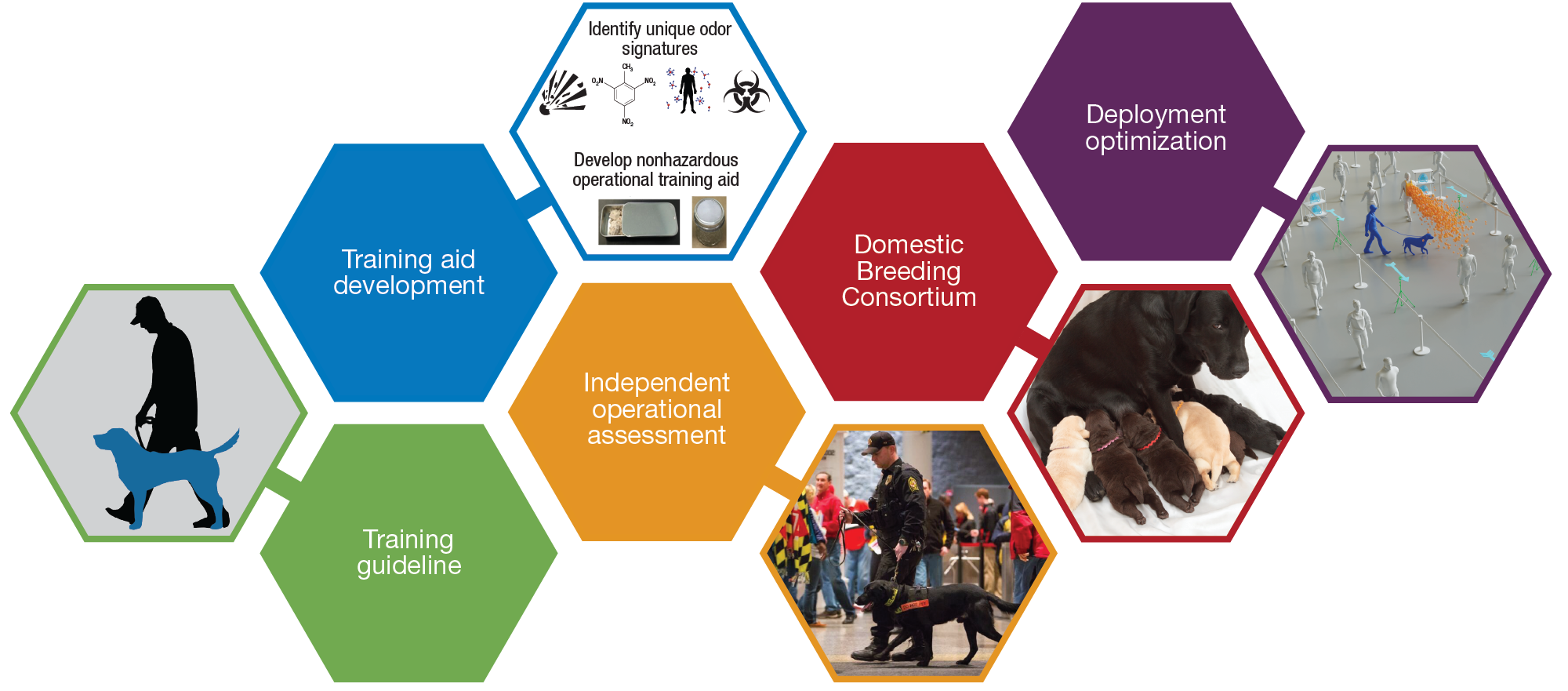
Domestic Breeding Consortium
As a key component of security measures in ports, airports, stadiums, and other public spaces, ODCs are critical to national security, public safety, and infrastructure in the United States. Explosives detection canines (EDCs) especially play a significant role in ensuring public safety and protection from explosive materials. Currently, most EDCs are sourced outside of the continental United States, a fact that Congress recognized as a potential threat to national security. In light of this, the House of Representatives passed the Domestic Explosives Detection Canine Capacity Building Act of 2017 directing the creation of a domestic breeding network to provide high-quality, effective EDCs.6 In 2019, APL started the Domestic Breeding Consortium (DBC) with the objective of meeting this congressional call. The DBC is a collaborative project focusing on developing evidence-based breeding and selection practices to strengthen and expand the domestic supply of ODCs, particularly EDCs.
The DBC has developed and deployed quantitative evaluations to monitor and support early and operational development as well as to create a more informed procurement structure. Additionally, APL has aggregated and documented a community best practices framework that both the private and public sectors can use to increase the knowledge and capabilities of organizations raising ODCs. Over its 3 years of existence, through the collaborative efforts of five partner organizations across the private and academic sectors, the DBC has produced 125 canines and successfully developed and placed 60 into primary, 12 into secondary, and 19 into tertiary positions (as EDCs, operational ODCs, and research ODCs, respectively). Two graduates from the DBC, pictured in Figure 2, were placed with the University of Maryland Police Department.
Figure 2
APL staff members, University of Maryland Police Department officers, and Domestic Breeding Consortium (DBC) canines.
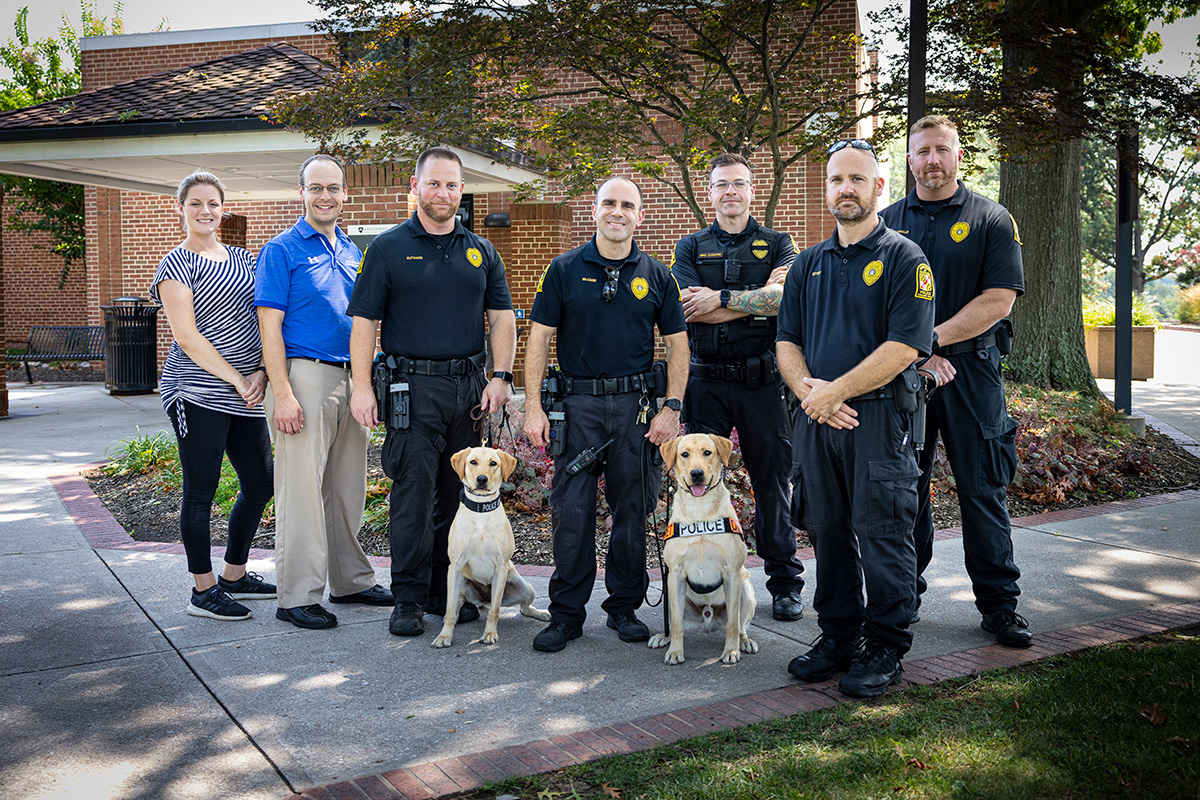
The team plans to integrate all aforementioned knowledge, practices, and analytical developments into a common platform to be distributed and used by the development, training, and deployment organizations. To fully understand the impact of applying scientific principles to breeding and developing ODCs, APL has created genetic references and is actively generating models to support the optimization of ODC discipline determination through not only development but also genetic optimization.7
Training Guideline
Another critical application of ODCs is person-borne explosives detection (PBED), which specifically involves the detection of explosive material carried by people, whether stationary or moving. Over the last decade, the Department of Homeland Security Science and Technology Directorate (DHS S&T) has prioritized research on the strengths and weaknesses of PBED canines, including factors that may impact their performance.8 In response to this call, APL developed a training guideline for uptraining traditional ODCs on expanded person-borne detection capabilities. The guideline, disseminated by DHS S&T,9 was developed based on input from ODC subject-matter experts and partner law enforcement agencies that deploy ODCs. Before this guideline was disseminated, many agencies relied on commercial sources for PBED training, and the training quality varied. The training guideline (Figure 3) provides detailed instructions as well as supplemental figures and videos, enabling agencies to conduct training in-house and ultimately giving more agencies the opportunity to deploy PBED canines.
Figure 3
APL-developed training guideline home page.
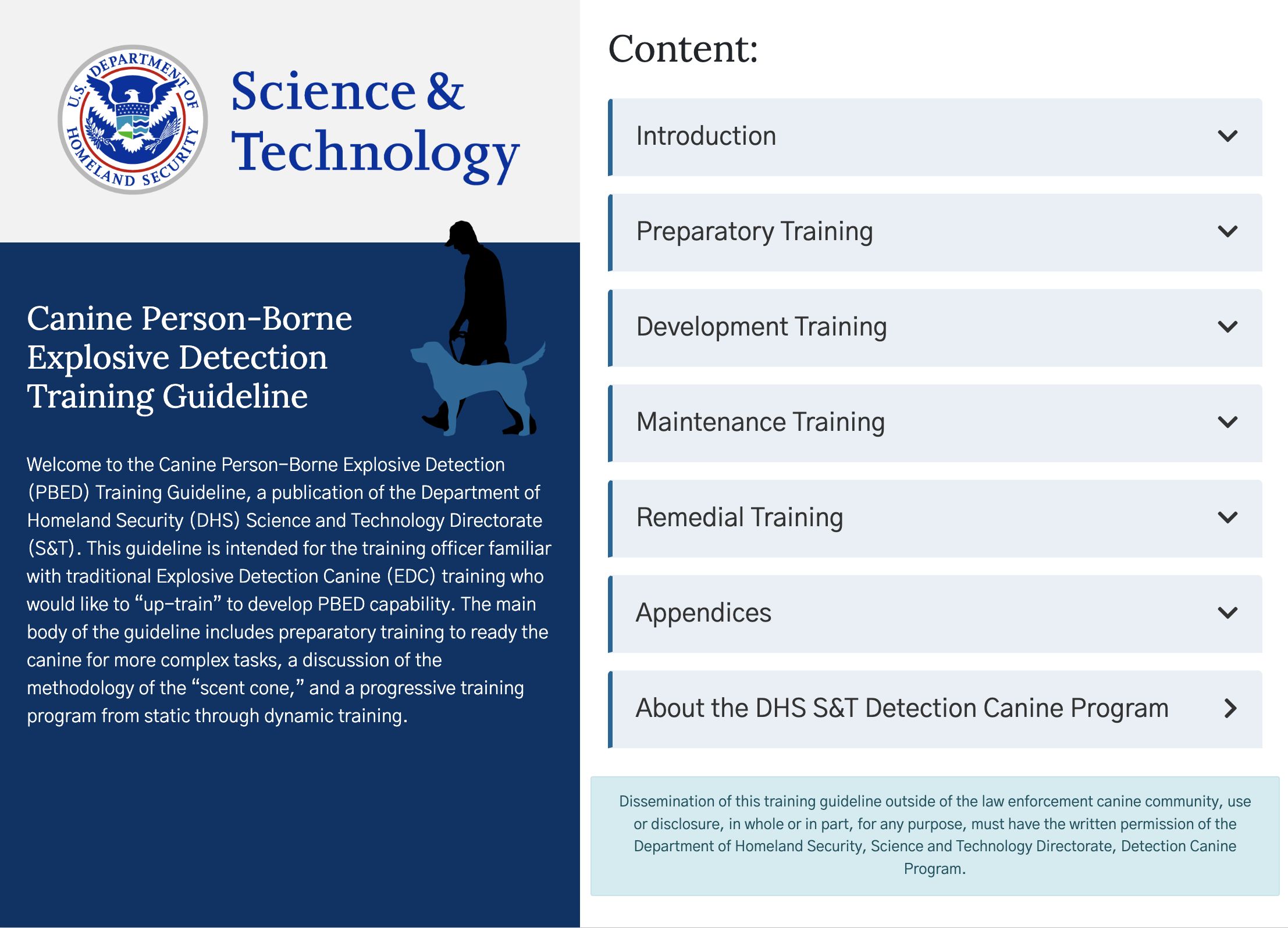
Training Aid Development
The ODC training process requires the use of specialized training aids (TAs) for each odor discipline. The TAs contain the odor the canines are being trained to detect. In the case of EDCs, the conventional TAs are generally small amounts of neat (i.e., in the form that would be used operationally) explosive material. Although the amounts used vary according to explosive type and individual agency preference, the use of neat explosive material introduces considerable safety and logistical limitations across all agencies employing EDCs. While most agencies maintain a TA supply for ongoing maintenance training, the limited stability of certain explosive materials prevents agencies from keeping even small amounts in-house. In these cases, EDC training with the explosive material may be limited because it requires an agency to have the appropriate qualifications to handle and transport the material.
These limitations led to the development of alternative TAs that reproduce or mimic the neat material’s odor profile but eliminate its safety hazards. These TAs can generally be categorized as dilution or derivative TAs. Dilution TAs contain the neat material, but it is rendered nonhazardous through means of altered concentration, mixture, or geometry. Derivative TAs do not contain the neat material, but rather a chemical derivative or product that is meant to be chemically or structurally analogous to the raw trained material.10 In contrast, TAs known as psuedo-TAs are the most common form of commercially available derivative TAs. They are primarily designed to reproduce the headspace generated by the neat material, as determined by gas chromatography–mass spectrometry (GC/MS).11 This approach has several limitations, the most significant of which is the assumption that the compounds identified by headspace analysis are the same as those the canine identifies to make a positive detection. Given that canines’ detection ability is known to be more sensitive than that of analytical instrumentation, it is not unreasonable to presume that canine detection of the trained odor may rely on compounds that are not detected by gas chromatography–mass spectrometry or similar approaches, which may include but are not limited to binders, solvents, or tagents.5 For this reason, dilution TAs are generally preferred as alternative TAs, particularly for explosive detection. Dilution TAs often take on the format of a mixture of neat material in an inert matrix, such as diatomaceous earth or silica gel. Because the neat material is sufficiently dispersed in the inert matrix, the dilution TA does not pose the hazards the neat TA does. Furthermore, low-volatility inert matrices make minimum contributions to the headspace of the material. Therefore, usually the dilution TAs’ headspace closely mimics the headspace of neat TAs and represents the entire odor profile rather than the profile of select compounds, as is generally the case with pseudo-TAs.
Because APL has experience in developing12 and evaluating TAs using both traditional analytical and canine methods, it is often called on to review the state of the science as well as commercially available products. Findings are documented in market survey reports, the most recent of which was published for the ODC community and general public through a collaboration with the National Urban Security Technology Laboratory (NUSTL) System Assessment and Validation for Emergency Responders (SAVER)13 and paired with an additional succinct TechNote summary.14
Independent Operational Assessment
Regardless of odor discipline, ODCs are deployed in an operational environment after extensive training. Because deployment can introduce variables that may have been absent or controlled during training, the transition from training to an operational space can affect ODC performance. To solve this issue, APL has partnered with several local agencies deploying EDCs, such as the University of Maryland Police Department and the Pentagon Force Protection Agency, to optimize the operational assessment process and provide expert recommendations for optimizing team performance. With these local partners, APL has conducted small-scale pilots to test assessment methodologies and deployment optimization techniques before performing them in collaboration with national organizations such as TSA.
Operational assessments of ODCs can reveal the influence of any number of variables on performance and likelihood of success. The assessments are designed by APL and reviewed by external subject-matter experts to ensure that the complexity of assessing a biological detector is reflected in the experimental plan. As a trusted independent evaluator, APL is well positioned, given its partnerships with the end-user community, to conduct these assessments, interpret the results, and provide tailored recommendations for potential improvements to canine training and deployment practices. This development cycle ensures that ODCs are trained and deployed through scientifically verifiable progressions.
Deployment Optimization
Many environmental factors are known or suspected to influence ODC performance in operational environments. One major factor of specific interest in the community is airflow. In light of this interest, APL undertook a substantial effort to develop airflow visualization and detection techniques to help handlers and trainers understand the potential impact of air movement in the dynamic operational environment. APL piloted the deployment of fieldable fogger kits (Figure 4) adapted from commercial off-the-shelf products.10 When using the fogger system during ODC training, handlers gained a better awareness of typical air movement patterns or behaviors directly in the operational environment.
Figure 4
Fogger kit. Left, fogger kit components; right, the kit deployed in a rolling suitcase.
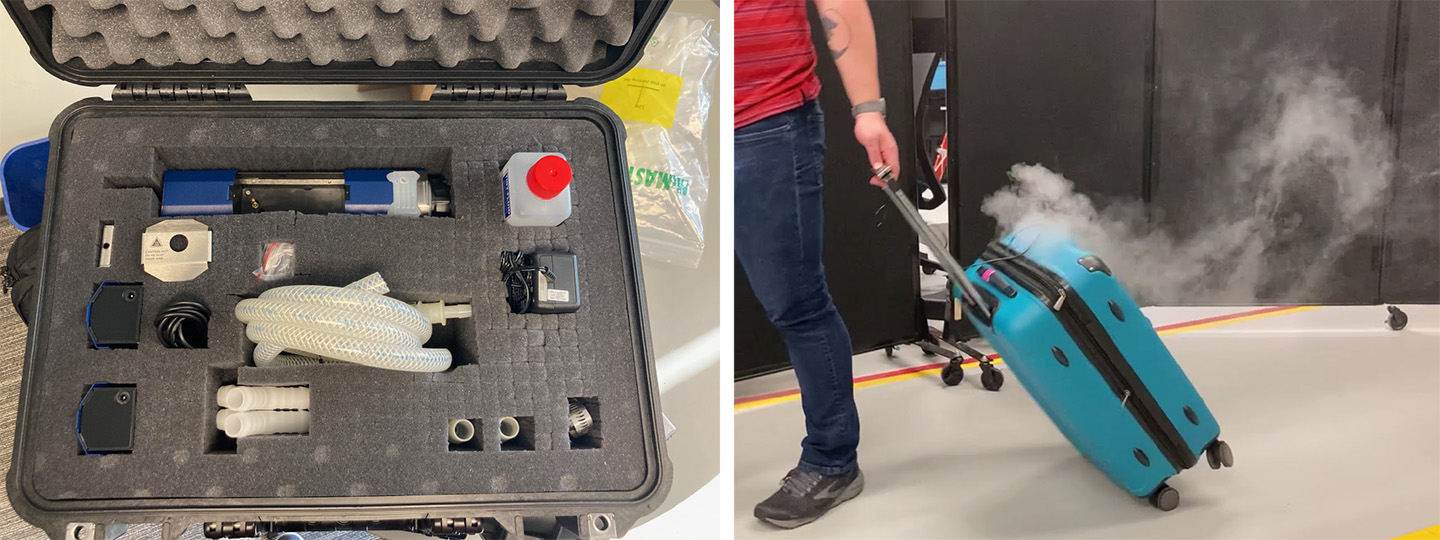
To further advance the capabilities and awareness of the ODC team, APL developed an advanced, fieldable sensor suite to give deployed teams and their agencies useful analytical knowledge of their operational environment. This knowledge is provided by a suite of self-contained anemometer-based units. These integrated units provide real-time situational awareness of their deployment environment through a graphical user interface. Handlers, trainers, and supervisors can then determine optimal deployment conditions with a more complete awareness of the environment and, when paired with knowledge ascertained through operational assessments, deploy with analytically informed and scientifically optimized efficacy. The anemometer array is shown in Figure 5 (green tripod structures) within the deployed advance queue configuration developed in collaboration with and fielded by TSA.
Figure 5
APL’s anemometer array concept.
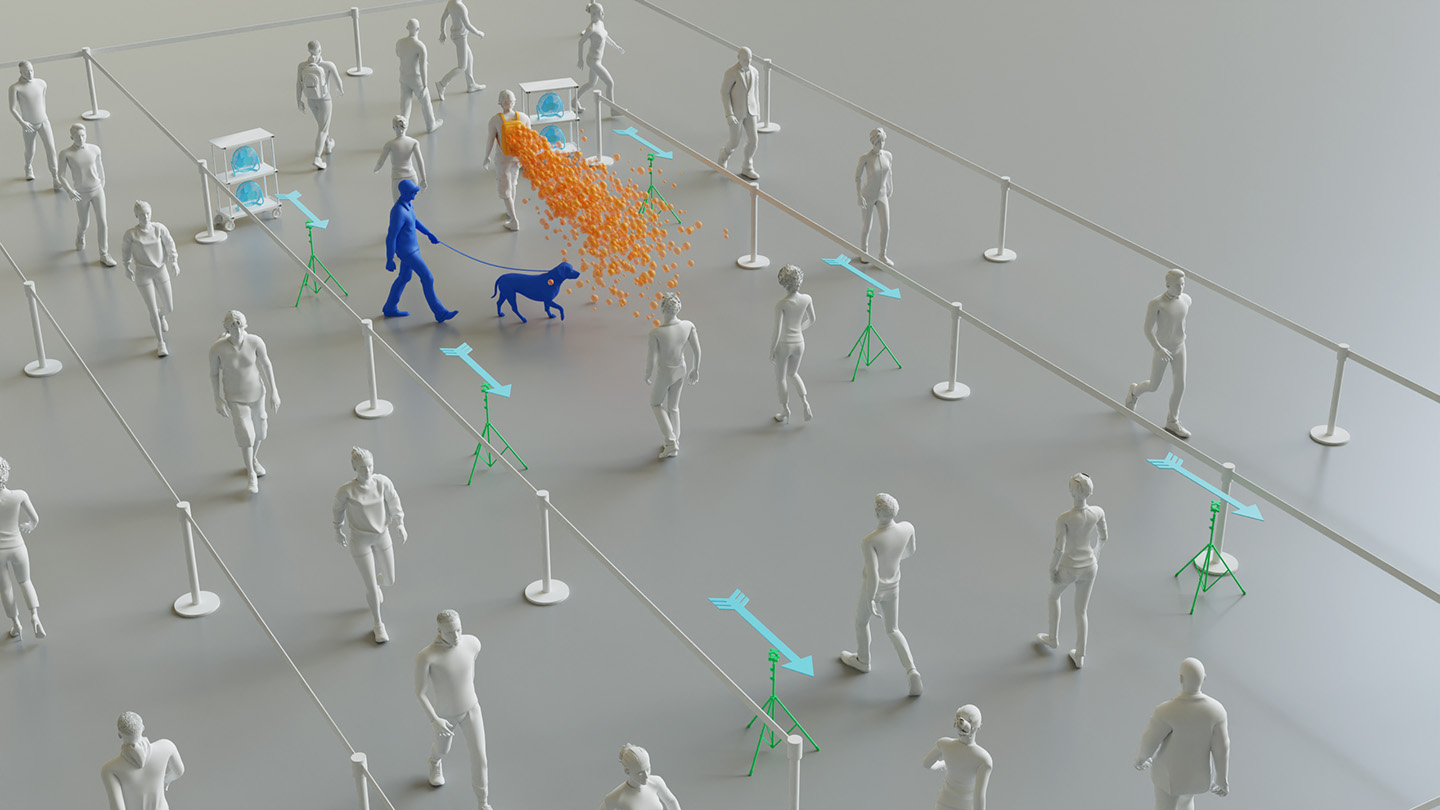
Conclusions
While inherently it may seem that canine-based detection is more limited than continually advancing state-of-the-art equipment and sensors, ODCs have proven to be an effective, sensitive, and dynamically fieldable solution for the nation’s defense against a wide range of threats. APL has contributed to the deployment, technologies, and information at all phases of the canine’s life and deployment in order to ensure advancement in the state of the science and capabilities of an invaluable fielded sensor platform that is integral to the safety and security of our nation.
Acknowledgments: The authors acknowledge the DHS S&T Detection Canine Program for its longstanding support. Key to the efforts described in this article are the invaluable partnerships with the University of Maryland Police Department, Pentagon Force Protection Agency, Fort Lauderdale Police Department, Maryland State Police, and the TSA. Additionally, the authors greatly appreciate collaborations with Aspen Creek Kennels, Auburn University, Katalyst Kennels, Project One Retrievers, Kreator LLC, and especially Person-Borne Detection K9. Key APL staff members who contributed to the work discussed in this article include Neal Baker, Jordan Johnson, Ashley Kilhefner, Karen Meidenbauer, Kathy Santos, and Megan Toms, with foundational work done by Mike House and Trang Vu.
- “TSA Canine Training Center.” Transportation Security Administration. https://www.tsa.gov/news/press/factsheets/tsa-canine-training-center (last updated May 19, 2021).
- “Canine Program.” US Customs and Border Protection. https://www.cbp.gov/border-security/canine-program (last modified Dec. 21, 2023).
- “National US&R Response System.” FEMA Canine. https://femacanine.org (accessed Jul. 5, 2024).
- P. Jendrny, F. Twele, S. Meller, A. D. M. E. Osterhaus, E. Schalke, and H. A. Volk, “Canine olfactory detection and its relevance to medical detection,” BMC Infect. Dis., vol. 21, art. 838, 2021, https://doi.org/10.1186/s12879-021-06523-8.
- A. Kokocińska-Kusiak, M. Woszczyło, M. Zybala, J. Maciocha, K. Barłowska, and M. Dzięcioł, “Canine olfaction: Physiology, behavior, and possibilities for practical applications,” Animals, vol. 11, no. 8, art. 2463, 2021, https://doi.org/10.3390/ani11082463.
- US House, 115th Cong. (2017-2018), H.R.4577, Domestic Explosives Detection Canine Capacity Building Act of 2017. https://www.congress.gov/bill/115th-congress/house-bill/4577.
- R. A. Player, E. R. Forsyth, K. J. Verratti, D. W. Mohr, A. F. Scott, and C. E. Bradburne, “A phased Canis lupus familiaris Labrador retriever reference genome utilizing high molecular weight DNA extraction methods and high resolution sequencing technologies” (preprint), bioRxiv, 2020, https://doi.org/10.1101/2020.08.26.269076.
- “Detection canine.” US Department of Homeland Security Science and Technology Directorate. https://www.dhs.gov/science-and-technology/detection-canine (last updated Jun. 14, 2024).
- “Canine person-borne explosive detection training guideline.” US Department of Homeland Security Science and Technology Directorate. https://www.dhs.gov/science-and-technology/publication/canine-person-borne-explosive-detection-training-guideline (last updated Aug. 16, 2022).
- M. Cerreta, “The creation and evaluation of novel canine training aids for cocaine using molecularly encapsulated sol-gel polymers and an investigation of canine field accuracy,” PhD dissertation, Florida International University, Miami, FL, 2015, https://doi.org/10.25148/etd.FI15032132.
- A. Simon, L. Lazarowski, M. Singletary, J. Barrow, K. Van Arsdale, T. Angle, P. Waggoner, and K. Giles, “A review of the types of training aids used for canine detection training,” Front. Vet. Sci., vol. 7, art. 313, 2020, https://doi.org/10.3389/fvets.2020.00313.
- D.-T. T. Vu, Process for producing non-detonable training aid materials for detecting explosives, US Patent US20140097551A1, filed Feb. 25, 2013, and issued Aug. 18, 2015. https://patents.google.com/patent/US20140097551A1/en.
- National Urban Security Technology Laboratory and Johns Hopkins University Applied Physics Laboratory, “Non-detonable training aids for explosives detection canines: Market Survey Report,” Washington, DC: US Department of Homeland Security Science and Technology Directorate, Feb. 2024. https://www.dhs.gov/sites/default/files/2024-03/24_03_12_st_caninetrainingaid_msr.pdf.
- National Urban Security Technology Laboratory, “Non-detonable training aids for explosives detection canines,” SAVER TechNote, Feb. 2024. https://www.dhs.gov/sites/default/files/2024-02/24_02_14_st_caninetrainingaids.pdf.
- D. Deglau and S. Klimkiewicz, “Airflow visualization tools for optimized search patterns in person-borne scenarios (A),” in Proc. Canine Olfaction and Detection Sci. Conf., May 25, 2023, https://eventsignup.fiu.edu/event/abstractdetails/991.
Shirley M. Klimkiewicz is an organic chemist in APL’s Asymmetric Operations Sector. She has a B.S. in chemistry from Princeton University and is pursuing a master’s in biotechnology, with a concentration in biodefense, at Johns Hopkins University. She has significant experience working with odor detection canines, specifically in designing and executing field assessments. She also has experience in biological assays, cell culture, and small-scale synthesis and analytical techniques, including nuclear magnetic resonance spectroscopy and gas chromatography–mass spectrometry.
David M. Deglau is a chemical engineer in APL’s Asymmetric Operations Sector. He has a B.S. in biochemistry from Saint Vincent College and an M.S. in chemical and biomolecular engineering from Johns Hopkins University. His professional focus is testing, evaluating, and developing prototype chemical detection systems. He has a broad range of experience with odor detection canines, gas and liquid control systems, carbon nanotubes, nanopore, and nanowires.